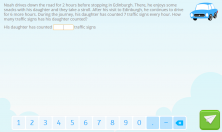In today’s post, we are going to present the way that we work on combined operations through word problems in Smartick.
In the field of mathematics in school, combined operations are those problems where we need to use more than one operation. If you don’t remember exactly what they were, click here to refresh your memory! On the other hand, a word problem is a problem that describes a real-life scenario which, as explained in this post, the method needed to solve it is unknown.
Let’s look at an example!
Example of Combined Operations with Word Problems: Counting Signs

In this word problem, there are three pieces of numerical data (2, 6, and 7). It is up to you to determine what to do with them. In particular, you have to decide what data is needed, what operation (or operations) to perform with it, and in what order. If you look at the units that those numbers have, we can see that the data is actually ”2 hours’‘, ”6 hours” and ”7 signs per hour.” On the other hand, the question is asking for the number of signs counted. Thus, one way to solve it is to first get the total number of hours Noah has driven and then apply the ratio of signs counted per hour. Let’s put it in mathematical language!
In order to calculate the total number of hours that Noah drove, you need to group the hours he drove before the stop in Edinburgh with those that he drove after. Then you will have the total number of hours…
2 + 6
Our result looks good so far because we are adding hours with hours, which gives us a result in hours. Now we have to multiply the result by the number of signs per hour. However, if we wrote it without making any changes, we would be wrong. Let’s see why. If we wrote…
2 + 6 × 7
we would have to first multiply 6 by 7 according to the order of operations. To solve this, we would use parentheses to represent what we want to be done first. In other words,
( 2 + 6 ) × 7
At this point, it is clear that by formalizing these problems we are also working on the combined operations. Finally, we just need to solve it.
( 2 + 6 ) × 7
8 × 7
56
So, the solution to the problem is ”His daughter counted 56 signs.”
I hope that this post has helped you realize that combined operations appear in various situations that happen every day and are critical to addressing everyday issues. If you would like to practice some more and continue learning mathematics, try the Smartick method for free. What are you waiting for?!
Learn More:
- Angles Explained with Clockhands
- How to Solve Multiplication Word Problems
- Combined Operations: How to Solve These Types of Problems
- What Are Combined Operations?
- The Relationship between Clocks and Angles







